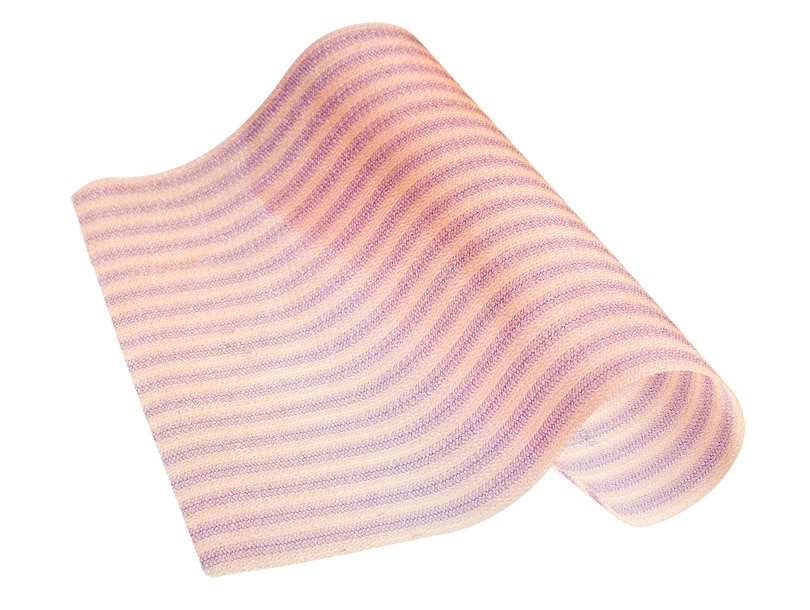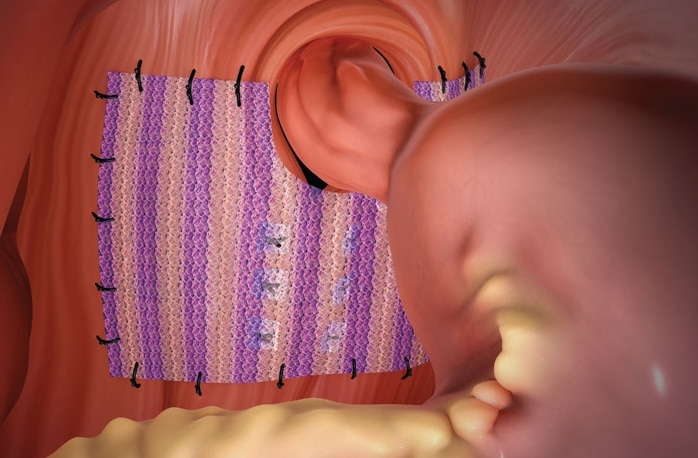
- Overview
- Products & Accessories
- EIFU & Resources
Phasix™ ST Mesh combines two market-leading technologies into one product: monofilament resorbable Phasix™ Mesh and a proven hydrogel barrier based on Sepra® technology. While the monofilament mesh supports functional healing and a strong repair, the hydrogel barrier minimizes tissue attachment to the visceral side of the mesh for intraabdominal placement.1
These meshes are available in different shapes, such as round, rectangle, and square.
For high-risk/comorbid patients, surgeons have had to choose between permanent synthetic meshes and biologic grafts—and their inherent pros and cons. Synthetic meshes can have complications that lead to mesh removal or reoperation, while biologic grafts can have accelerated degradation in the presence of bacteria which may lead to mesh failure.
Phasix™ ST Mesh handles, sutures and fixates like a synthetic mesh, while exhibiting the remodeling characteristics of a biologic mesh. It facilitates trocar deployment during laparoscopic placement.
The ST hydrogel barrier
- Minimizes risk of tissue attachment
- Has over 10 years of clinical application
- Resorbs in 30 days
- 15 clinical studies
The Phasix™ ST Mesh is a biologically derived scaffold with a hydrogel barrier for intraabdominal placement. It has been designed to provide the repair strength of a synthetic mesh and the remodeling characteristics of a biologic.
The Phasix™ ST Mesh does the following:
- Handles, sutures and fixates like a synthetic mesh
- Facilitates trocar deployment during laparoscopic placement
- Its longitudinal stripes aid with orientation and visibility during placement
MATERIAL STRUCTURE1
Monofilament mesh designs have been shown more biocompatible and less susceptible to bacterial adherence and colonization.
REPAIRS HERNIAS1
The open monofilament mesh structure provides early integration and repair strength.1
REMODELS ISSUES OVER TIME1
Vascular integration and incorporation continues, with abundant mature collagen at 52 weeks. Gradually transfers load to native tissue over time.1
VERSATILE TECHNIQUES1
Phasix™ ST Mesh may be placed in either an intraabdominal or preperitoneal position after primary hernia defect closure. Primary hernia defect closure should be achieved prior to placing the mesh.
HERNIA DEFECT CLOSURE
Hernia defect closure can be achieved through an open or minimally invasive approach (i.e., laparoscopic, robotic). Recent studies suggest potential advantages of defect closure include:
• Decreased “dead” space, which can reduce the risk of postoperative seromas
• May contribute to restoration of a functional abdominal wall
• May reduce postoperative bulging at the hernia defect site
PROMISING RESULTS IN THE PRESENCE OF BACTERIA
Phasix™ ST Mesh has not been shown to break down in the presence of bacteria—maintaining 100% of its strength at 56 days —unlike biologic grafts which demonstrate accelerated degradation in the presence of bacteria.
As shown in the graphic below, there was no presence of bacterial colonization observed in Phasix™ Mesh or Phasix™ ST Mesh 7 days post-inoculation in preclinical testing. The other side of this graph shows the presence of abscess (white material) observed SurgiMend® , Strattice™, Bio - A®, and OviTex™. Other observed indications of bacterial colonization included swelling, presence of fluids, and thickened capsule tissue.
1. Deeken CR, Matthews BD. “Characterization of the mechanical strength, resorption properties, and histologic characteristics of a fully absorbable material (Poly-4-hydroxybutyrate-Phasix™ Mesh) in a porcine model of hernia repair.” ISRN Surgery 2013; 1-12. RPT3807332.
2. DeMeester, Steven R, et al. Combination of surgical technique and bioresorbable mesh reinforcement of the crural repair leads to low early hernia recurrence rates with laparoscopic paraesophageal hernia repair. J Gastrointest Surg. 2020
1. Deeken CR, Matthews BD. “Characterization of the mechanical strength, resorption properties, and histologic characteristics of a fully absorbable material (Poly-4-hydroxybutyrate-Phasix™ Mesh) in a porcine model of hernia repair.” ISRN Surgery 2013; 1-12. RPT3807332.
2. DeMeester, Steven R, et al. Combination of surgical technique and bioresorbable mesh reinforcement of the crural repair leads to low early hernia recurrence rates with laparoscopic paraesophageal hernia repair. J Gastrointest Surg. 2020
BD's collection of literature on industry and on our offerings gives you information you can use to continue striving for excellence.
BD supports the healthcare industry with market-leading products and services that aim to improve care while lowering costs. We host and take part in events that excel in advancing the world of health™.
The BD Learning Academy offers a centralized repository of BD product training, education, and the ability to connect courses to your LMS.
We promote clinical excellence by providing various resources on best practices, clinical innovations and industry trends in healthcare.
1. Deeken CR, Matthews BD. “Characterization of the mechanical strength, resorption properties, and histologic characteristics of a fully absorbable material (Poly-4-hydroxybutyrate-Phasix™ Mesh) in a porcine model of hernia repair.” ISRN Surgery 2013; 1-12. RPT3807332.
2. DeMeester, Steven R, et al. Combination of surgical technique and bioresorbable mesh reinforcement of the crural repair leads to low early hernia recurrence rates with laparoscopic paraesophageal hernia repair. J Gastrointest Surg. 2020

